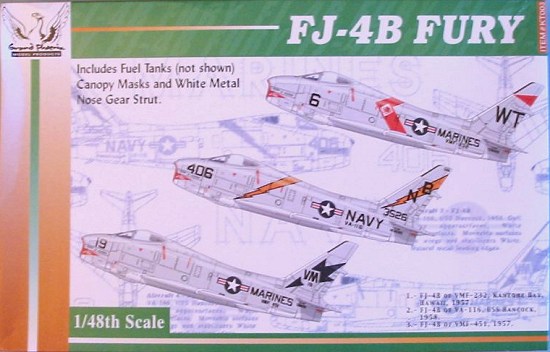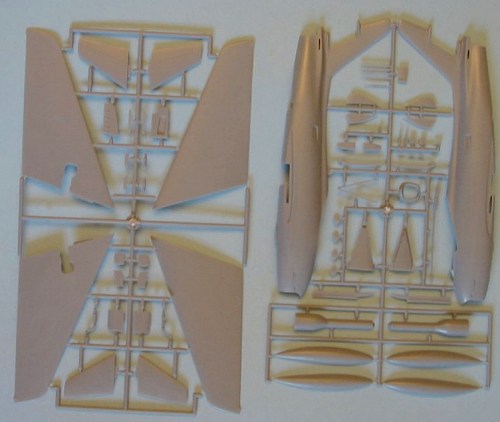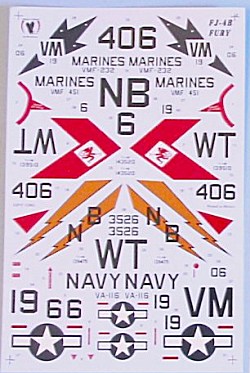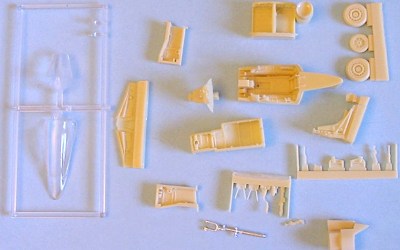
|
KIT: |
Grand Phoenix 1/48 FJ-4 Fury |
|
KIT # |
0003 |
|
PRICE: |
$49.99 MSRP |
|
DECALS: |
Three aircraft |
|
REVIEWER: |
|
|
NOTES: |
Short run with resin. |

|
HISTORY |
I once listened to a very senior retired Marine aviator state unequivocally that the best fighter he ever flew in his entire career - which spanned from World War II to past Vietnam - was the North American FJ-4 "Fury." He went so far as to say that "if they'd have put an afterburner in it, I could've waxed any Crusader in the sky."
The FJ-4 Fury was the last of a line of naval fighters developed by North American Aviation from their F-86 Sabre land-based fighter. In 1952, the Navy knew it was totally outclassed over Korea by the MiG-15, and turned to North American to make a version of the only Western fighter at the time that could successfully take on the MiG-15, the Sabre. The FJ-2 Fury equipped Marine units and did not see much if any carrier service, while the FJ-3 became one of the backbones of Navy fighter aviation in the mid-1950s.
The FJ-3 had its slats removed and replaced with the "6-3" wing leading edge during 1955, with no adverse performance in deck handling, and a considerable increase in air combat performance at altitude. As early as 1953, North American had brought the NA-208 to the Navy as "the ultimate Fury." This was a complete redesign of the Fury, that left the resulting FJ-4 with almost nothing in common with the FJ-3 or the F-86 other than a general planform.
The FJ-4 was powered by the same J-65 development of the English Sapphire jet engine as the FJ-3, with a completely redesigned fuselage that was shorter and deeper than the previous models, with a wing that was increased in size 40 percent, doing away completely with the leading edge slats. While the FJ-4 was heavier than the earlier airplanes, with a resultant loss of climb rate and ceiling, that wing gave it the maneuverability referred to by the retired Marine above, to "wax the tail of anything in the sky."
The FJ-4 originally was equipped with four underwing pylons for external fuel and sidewinder missiles. With the introduction of the FJ-4B,optimized for ground attack, another pair of pylons appeared outboard of the fuel tanks. In 1957, the Fury was the first Navy attack aircraft to fire the Bullpup air-to-ground radar-guided missile. The FJ-4B was also cleared to carry a nuclear weapon.
The FJ-4 equipped nine Navy and three Marine squadrons between 1957-60. In 1958, FJ-4Bs of VMF-212 and VMF-214 made the first transpacific flights by single-seat naval aircraft.
|
THE KIT |

The only other 1/48 kit of the FJ-4 Fury was released by Matchbox in 1982. It has been unavailable other than through kit collectors since the late 80s. While essentially accurate in outline, there was a lot of scratchbuilding to be done by any modeler who wanted to make that kit into a worthwhile model.
This Grand
Phoenix kit ges a long way toward delivering a state-of-the-art kit of
this airplane for modelers who enjoy Naval aircraft of the 50s. The
limited-run injection-molded parts were done in the Czech Republic, and
feature acceptably-thin trailing edges, and petite engraved surface
detail. A couple of "naval aircraft experts" have bemoaned the fact it
doesn't have leading edge slats that can be modeled in the down position
but - as mentioned above - the FJ-4 series never had those slats. Thus,
the kit is quite accurate as it sits. I have yet to see a photo of one
on the ground with dive brakes out and flaps dropped, so the fact that
you can do neither with the kit should not be counted against it. Test
fitting the wings to the fuselage show there should be no problems that
cannot be solved with an application of Mr. Surfacer aroun d
the joints.
d
the joints.
 The resin parts
are done by Aires, and are excellent. The cockpit tub presents excellent
detail, and the seat is very accurate. The wheel wells and rear fuselage
are also in resin. Photo-etch parts provide the instrument panel, the
seatbelts, and various levers, rearview mirrors, etc.
The resin parts
are done by Aires, and are excellent. The cockpit tub presents excellent
detail, and the seat is very accurate. The wheel wells and rear fuselage
are also in resin. Photo-etch parts provide the instrument panel, the
seatbelts, and various levers, rearview mirrors, etc.
The clear parts are a bit thick, but should look fine under a coat of Future. The canopy is designed to be displayed in the open position - a good idea with that nice cockpit to show off.
The decals are superb, being designed by Eagle Strike. They provide very colorful markings for an FJ-4B of VMF-232 "Red Devils" and one from VA-116 with orange lightning flashes, and another from VMF-451 with a very striking black dart on the vertical fin. There are no stencil decals, but these can be cobbled together from other sheets if you "gotta have 'em."
|
CONCLUSIONS |
This is an excellent contribution to the growing list of Navy fighters of the 50s now available and will look good sitting next to your Skyhawks and Skyrays. Construction appears simple for those who are hesitant to pick up limited-run kits.
Review Kit Courtesy of North American Hobbies.
If you would like your product reviewed fairly and quickly by a site that has over 200,000 visitors a month, please contact me or see other details in the Note to Contributors.